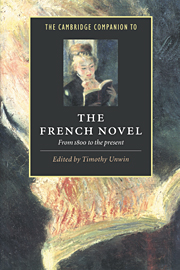Book contents
- Frontmatter
- 1 On the novel and the writing of literary history
- 2 Novels of testimony and the 'invention' of the modern French novel
- 3 Reality and its representation in the nineteenth-century novel
- 4 Women and fiction in the nineteenth century
- 5 Popular fiction in the nineteenth century
- 6 Decadence and the fin-de-siècle novel
- 7 The Proustian revolution
- 8 Formal experiment and innovation
- 9 Existentialism, engagement, ideology
- 10 War and the Holocaust
- 11 From serious to popular fiction
- 12 The colonial and postcolonial Francophone novel
- 13 The French-Canadian novel
- 14 Gender and sexual identity in the modern French novel
- 15 Postmodern Frenchfiction
- General bibliography
- Index
4 - Women and fiction in the nineteenth century
Published online by Cambridge University Press: 28 May 2006
- Frontmatter
- 1 On the novel and the writing of literary history
- 2 Novels of testimony and the 'invention' of the modern French novel
- 3 Reality and its representation in the nineteenth-century novel
- 4 Women and fiction in the nineteenth century
- 5 Popular fiction in the nineteenth century
- 6 Decadence and the fin-de-siècle novel
- 7 The Proustian revolution
- 8 Formal experiment and innovation
- 9 Existentialism, engagement, ideology
- 10 War and the Holocaust
- 11 From serious to popular fiction
- 12 The colonial and postcolonial Francophone novel
- 13 The French-Canadian novel
- 14 Gender and sexual identity in the modern French novel
- 15 Postmodern Frenchfiction
- General bibliography
- Index
Summary
Staël, Sand, Rachilde: we now remember women's contribution to the nineteenth-century French novel as a few exceptional figures leaving their mark on a genre dominated by men. But women were in fact the most acclaimed practitioners of the novel when the century opened and integral to the novel's development during what critics have long considered its 'golden age'. If their importance has subsequently been forgotten, it is the result of literary battles which this chapter describes. The nineteenthcentury novel takes shape in struggles between the sentimental form which reigns at the beginning of the century and newly-emerging realism which will come to supplant it. Throughout these struggles, female novelists overwhelmingly prefer sentimental codes.
The history of the nineteenth-century novel has long been written from the standpoint of the victorious realist aesthetic. This chapter brushes such literary history against the grain. It isolates four phases in women's contribution to the nineteenth-century novel that are inseparable from the prestige and decline of the sentimental form. From the Revolution to 1830, the most important novels are sentimental novels written by women. During the years 1830-1850, realism takes shape in a struggle to displace the sentimental novel, but the contest has no clear winner. The years 1850-80 correspond to the triumph of the realist aesthetic and women writers' disappearance from the vanguard of the novel. At the century's end, women writers once more emerge as important presences in the novel, and their contributions now cover the spectrum of possible novelistic forms (sentimental, realist, decadent).
- Type
- Chapter
- Information
- The Cambridge Companion to the French NovelFrom 1800 to the Present, pp. 54 - 72Publisher: Cambridge University PressPrint publication year: 1997
- 1
- Cited by



